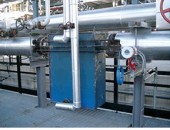 The new 2-axis modules from B&R's ACOPOS P3 series feed braking energy back into the mains. This function significantly improves the overall effectiveness of a machine. With just 500 watts of regenerative braking power, the function pays for itself in only a year.
The new 2-axis modules from B&R's ACOPOS P3 series feed braking energy back into the mains. This function significantly improves the overall effectiveness of a machine. With just 500 watts of regenerative braking power, the function pays for itself in only a year.
A prime candidate for this function are machine tools, whose headstock spindle drives generate large amounts of braking energy that would otherwise go unused. The function is also well suited for conveyor systems that move heavy loads vertically. Without power regeneration, not only would the braking energy go to waste, but the resulting heat would require additional cooling and consume even more power.
Regenerative braking is implemented particularly efficiently in the new 2-axis modules from the ACOPOS P3 series. One of the axes is configured as the feedback path to return excess power to the mains.
Additional functions with ACOPOSmulti
Like the new ACOPOS P3, the active power supply modules from the ACOPOSmulti series also support regenerative braking. These models also offer other helpful functions such as stabilization of the DC bus voltage and compensation of the reactive power.

 Rotork Fairchild has launched a new range of compact low pressure I/P (electro-pneumatic) transducers for instrument, analytical and scientific control applications.
Rotork Fairchild has launched a new range of compact low pressure I/P (electro-pneumatic) transducers for instrument, analytical and scientific control applications. Yokogawa Electric Corporation has announced that it will release an enhanced version of the STARDOM™ network-based control system in the spring of 2016 that includes a newly developed high-speed CPU module for the FCN autonomous controller. Based on the concept of putting forward a product that is Faster, Stronger, Smarter, STARDOM will feature the new CPU module, improved environmental resistance, and an enhanced engineering tool. With this product, Yokogawa intends to expand the open network control system business.
Yokogawa Electric Corporation has announced that it will release an enhanced version of the STARDOM™ network-based control system in the spring of 2016 that includes a newly developed high-speed CPU module for the FCN autonomous controller. Based on the concept of putting forward a product that is Faster, Stronger, Smarter, STARDOM will feature the new CPU module, improved environmental resistance, and an enhanced engineering tool. With this product, Yokogawa intends to expand the open network control system business. Rotork Skilmatic electro-hydraulic valve actuators have been ordered for increased safety ESD (Emergency Shutdown) duties on two new oil pipelines in China. Owned by the China National Petroleum Corporation, the Mahui and Yunnan Pipelines are attached to the network bringing oil and gas to China from offshore fields in the Bay of Bengal.
Rotork Skilmatic electro-hydraulic valve actuators have been ordered for increased safety ESD (Emergency Shutdown) duties on two new oil pipelines in China. Owned by the China National Petroleum Corporation, the Mahui and Yunnan Pipelines are attached to the network bringing oil and gas to China from offshore fields in the Bay of Bengal. The special challenge of this application is the exact temperature of the heat-tracing, which must be adapted to the type of Bitumen used. The meters must be rugged and temperature-stable, and should not affect the accuracy of potential custody transfer devices.
The special challenge of this application is the exact temperature of the heat-tracing, which must be adapted to the type of Bitumen used. The meters must be rugged and temperature-stable, and should not affect the accuracy of potential custody transfer devices.